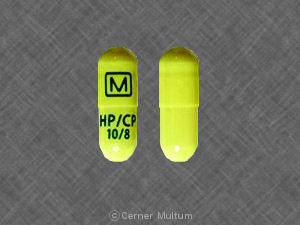Chlorpheniramine / Hydrocodone Dosage
Medically reviewed by Drugs.com. Last updated on Jul 21, 2025.
Applies to the following strengths: 4 mg-5 mg; 8 mg-10 mg; 8 mg-10 mg/5 mL; 2 mg-2.5 mg/5 mL; 4 mg-5 mg/5 mL
Usual Adult Dose for:
Additional dosage information:
Usual Adult Dose for Cold Symptoms
Immediate-release (IR): 5 mL orally every 4 to 6 hours as needed
Maximum dose: 20 mL in 24 hours
- Each 5 mL of IR oral solution contains hydrocodone bitartrate 5 mg with chlorpheniramine maleate 4 mg
Extended-release (ER): One dose orally every 12 hours
Maximum dose: 2 doses in 24 hours
- A dose equals 1 ER capsule or 5 mL ER suspension; each dose provides hydrocodone polistirex equivalent to 10 mg of hydrocodone bitartrate and chlorpheniramine polistirex equivalent to 8 mg chlorpheniramine maleate
Comments:
- Oral solution and suspension must be measured with an accurate milliliter measuring device; do not use a household teaspoon.
Use: For the symptomatic relief of cough and upper respiratory symptoms associated with allergy or a cold.
Usual Adult Dose for Cough
Immediate-release (IR): 5 mL orally every 4 to 6 hours as needed
Maximum dose: 20 mL in 24 hours
- Each 5 mL of IR oral solution contains hydrocodone bitartrate 5 mg with chlorpheniramine maleate 4 mg
Extended-release (ER): One dose orally every 12 hours
Maximum dose: 2 doses in 24 hours
- A dose equals 1 ER capsule or 5 mL ER suspension; each dose provides hydrocodone polistirex equivalent to 10 mg of hydrocodone bitartrate and chlorpheniramine polistirex equivalent to 8 mg chlorpheniramine maleate
Comments:
- Oral solution and suspension must be measured with an accurate milliliter measuring device; do not use a household teaspoon.
Use: For the symptomatic relief of cough and upper respiratory symptoms associated with allergy or a cold.
Renal Dose Adjustments
Severe renal impairment: Use with caution
Liver Dose Adjustments
Severe hepatic impairment: Use with caution
Dose Adjustments
Elderly: Use with caution
Precautions
The US FDA requires a Risk Evaluation and Mitigation Strategy (REMS) for all opioids intended for outpatient use. The new FDA Opioid Analgesic REMS is a designed to assist in communicating the serious risks of opioid pain medications to patients and health care professionals. It includes a medication guide and elements to assure safe use. For additional information: www.accessdata.fda.gov/scripts/cder/rems/index.cfm
US BOXED WARNING: RISKS FROM CONCOMITANT USE WITH BENZODIAZEPINES OR OTHER CNS DEPRESSANTS; RISK EVALUATION AND MITIGATION STRATEGY (REMS):
- Concomitant use of opioids with benzodiazepines or other CNS depressants, including alcohol, may result in profound sedation, respiratory depression, coma, and death. Avoid use of opioid cough medications in patients taking benzodiazepines, other CNS depressants, or alcohol.
- Opioid Analgesic REMS: To ensure that the benefits of opioid analgesics outweigh the risks of addiction, abuse, and misuse, a REMS is required for these products. Under the requirements of the REMS, drug companies with approved opioid analgesic products must make REMS-compliant education programs available to healthcare providers. Healthcare providers are strongly encouraged to complete a REMS-compliant education program; counsel patients and/or their caregivers, with every prescription on safe use, serious risks, storage, and disposal of these products; emphasize to patients and their caregivers the importance of reading the Medication Guide every time it is provided by their pharmacist, and consider other tools to improve patient, household, and community safety.
Safety and efficacy of the immediate-release oral solution have not been established in patients younger than 18 years.
The US FDA recommends against use of hydrocodone-containing cough and cold medications in patients less than 18 years because it has been determined that the risks outweigh benefits.
Consult WARNINGS section for additional precautions.
US Controlled Substance: Schedule II (oral suspension/oral solution); Schedule III (oral capsules)
Dialysis
Data not available
Other Comments
Administration advice:
- Shake suspension well prior to measuring
- Measure oral solution and oral suspension with an accurate measuring device; a household teaspoon is not an accurate measuring device
General:
- Leading pediatric and pulmonary health organizations recommend against symptomatic treatment of cough in pediatric patients due to lack of efficacy studies and the possibility of significant morbidity and mortality; benefit to risk should be carefully considered in pediatric patients with respiratory compromise.
- The US FDA recommends against use of hydrocodone-containing cough and cold medications in patients less than 18 years because it has been determined that the risks outweigh benefits.
Monitoring:
- Monitor for the development of addiction, abuse, or misuse
Patient advice:
- Advise patients to store this drug safely out of the sight and reach of children; accidental use by a child is a medical emergency and can result in death.
- Patients should understand the risks of life-threatening respiratory depression, and should be informed as to when this risk is greatest.
- Women of child bearing potential should understand that prolonged opioid use during pregnancy can result in neonatal opioid withdrawal syndrome and that prompt recognition and treatment will be necessary; breastfeeding women should speak to their health care provider prior to using this drug.
- Patients should be instructed in proper disposal.
- Patients should not consume alcoholic beverages or take this drug with benzodiazepines or other CNS depressants; patients should avoid driving or operating machinery while taking this drug.
- Patients should be instructed to read the US FDA-approved Medication Guide each time this drug is dispensed; they should understand the safe use, serious risks, and proper storage and disposal of this drug.
More about chlorpheniramine / hydrocodone
- Check interactions
- Compare alternatives
- Pricing & coupons
- Reviews (133)
- Side effects
- During pregnancy
- Drug class: upper respiratory combinations
- En español
Patient resources
- Chlorpheniramine and hydrocodone drug information
- Hydrocodone and chlorpheniramine (Advanced Reading)
- Hydrocodone and chlorpheniramine polistirex (Advanced Reading)
Other brands
Tussionex Pennkinetic, TussiCaps, Vituz
Professional resources
- Hydrocodone Polistirex and Chlorpheniramine Polistirex Suspension prescribing information
- Hydrocodone and Chlorpheniramine (FDA)
- Hydrocodone and Chlorpheniramine Solution (FDA)
Other brands
Related treatment guides
See also:
Further information
Always consult your healthcare provider to ensure the information displayed on this page applies to your personal circumstances.


